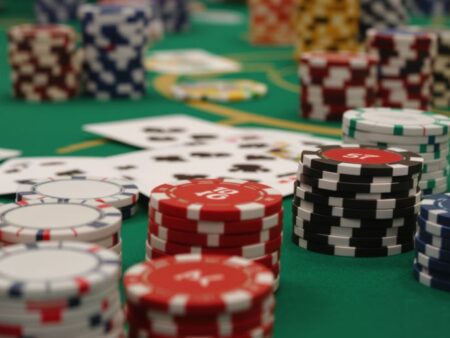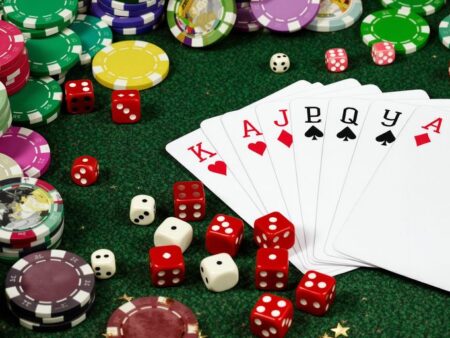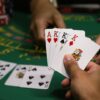So, you’ve decided to jump into the world of online poker? That’s great! It’s a lot of fun, but let’s be honest, it can be a bit of a minefield for newcomers. I remember my first few sessions – pure chaos. I was splashing chips around like they were going out of fashion and getting absolutely creamed. It turns out, there are a few common mistakes beginners make in online poker that really put a dent in your progress, and your wallet. But don’t worry, we’ve all been there. This article is all about spotting those common pitfalls so you can avoid them and actually start enjoying the game, maybe even winning a bit.
Key Takeaways
- Playing too many hands is a big one. You really need to be selective with your starting cards, especially when you’re in early positions. Patience is key here; wait for good hands instead of just playing anything.
- Don’t get too attached to your cards, especially if the board doesn’t look great. Always think about what your opponents might have and how the community cards affect your hand’s strength.
- Your position at the table is super important. Acting later gives you more information, so play tighter when you’re early and loosen up a bit when you’re late to take advantage.
- Online poker is faster and lacks physical tells. You need to adjust your strategy, maybe use tracking software, and be ready to make decisions quicker than you might in a live game.
- Look after your money! Set limits for each session, make sure you have enough buy-ins for the stakes you’re playing, and never try to win back losses in one go.
Playing Too Many Hands
This is probably the most common mistake new players make, and honestly, it’s easy to see why. The action online moves so fast, and you just want to get involved, right? But playing too many hands, especially ones that aren’t that great, is a surefire way to bleed chips. Data from last year showed that a massive chunk of losing players just couldn’t bring themselves to fold when they should have. It’s like wanting to jump into every conversation, even when you don’t really have anything to add – it just slows things down and can make you look a bit silly.
Be Selective With Starting Hands
It sounds obvious, but you really need to be picky about what you play. Not every hand is a winner, and trying to force a win with a weak hand is a losing game. Think about it – you wouldn’t try to build a house with rotten timber, would you? Stick to hands that have a decent chance of winning, especially when you’re in the early positions at the table. High pairs, suited connectors, and strong suited cards are generally your best bet.
Understand Your Position
Position is everything in poker. Acting later in a betting round gives you a huge advantage because you see what everyone else does first. This means you can play a wider range of hands when you’re in late position, like the button or cutoff. But when you’re in early position, you’ve got no idea what your opponents are holding, so you need to tighten up and only play your strongest hands. It’s like being the last person to pick a team – you get to see who’s left and make a better choice.
Use A Starting Hand Chart
If you’re not sure which hands are worth playing, a starting hand chart is your best mate. These charts basically tell you what hands are profitable to play from each position. They’re not set in stone, but they give you a solid foundation to build on. Think of it as a cheat sheet for the early days. You can find plenty of these online, just do a quick search for ‘poker starting hand charts’.
Practice Patience
This is a tough one, especially online when the action is constant. You’ll often find yourself with nothing decent to play for ages. The key is to resist the urge to jump in with any old hand just to feel like you’re doing something. Folding is a skill, and a very important one. Wait for those spots where you have a real edge, a strong hand, or a good read on your opponents. It’s a marathon, not a sprint, and patience will save you a lot of money in the long run.
Overvaluing Weak Hands
Right, so you’ve got a hand, maybe it started off looking pretty decent, but then the flop comes down and suddenly it’s not looking so flash. A common trap beginners fall into is getting too attached to these hands, even when the evidence suggests they’re probably beat. It’s like stubbornly holding onto a losing lottery ticket because you spent a few bucks on it.
Evaluate Board Texture
The community cards are a big deal. That top pair you hit on a dry board? Might be gold. But if the board suddenly has a bunch of connected cards, like a 7-8-9 with two hearts, and you’ve only got a pair of Kings? Suddenly, your hand isn’t looking so strong anymore. You’ve got to consider what hands your opponents could have that beat yours based on what’s showing on the table.
Consider Opponent’s Actions
Your opponents are giving you clues with every bet and raise. If someone’s been betting big and aggressively, and you’ve only got, say, two pair on a board that could easily make a straight or a flush, you’ve got to wonder if they’ve got the nuts. Don’t just assume your hand is still good because it was good on the flop. Their actions matter a heap.
Avoid Attachment To Hands
This is a tough one, but you really need to try and detach your emotions from your cards. Just because you played a hand a certain way, or you’ve put money in, doesn’t mean you have to keep going. If the situation looks bad, and your hand is likely behind, the best play is often to just fold. It saves you more chips in the long run.
Use Pot Control
When you’ve got a hand that’s okay, but not amazing, it’s smart to try and keep the pot small. This means checking when you can, or just calling instead of betting or raising. It stops you from getting into a massive pot with a hand that might only be good enough to win a small one. You want to get to showdown cheaply if your hand is marginal.
Ignoring Positional Advantage
Right, so, position. It’s one of those things in poker that sounds simple, but heaps of beginners just don’t get it. Basically, position means where you are sitting relative to the dealer button. The later you act in a betting round, the more information you’ve got about what everyone else has done. This is a massive deal, honestly.
Play Tighter From Early Positions
When you’re one of the first people to act, you’ve got no idea what anyone else is going to do. They could have anything from a pair of twos to pocket aces. Because of this, you really need to be super selective with the hands you play. Stick to the really strong stuff – think big pairs, or ace-king. Playing weaker hands from early on is just asking for trouble, you’ll often find yourself in tough spots where you’re out of position and have to make difficult decisions.
Loosen Up In Late Positions
Now, when you’re acting later, say on the button or the cutoff, things change. You’ve seen what everyone before you has done. If they’ve all folded, you can often just take the blinds with a raise. If a couple of people have limped in, you can raise to try and isolate them or steal the pot. You can play a much wider range of hands from late position because you have that information advantage. It’s like having a bit of a crystal ball, not perfect, but way better than nothing.
Steal The Blinds
This is a direct benefit of being in late position. When it’s folded around to you and you’re on the button or cutoff, a raise can often win you the blinds and antes without even seeing a flop. It’s a simple way to add chips to your stack. Just don’t do it every single time, or people will start calling you down with any old rubbish, and then you’re in a bad spot.
Control The Pot
Position also helps you manage how big the pot gets. If you’re in late position and you have a decent hand, but you’re not sure if it’s the absolute nuts, you can check behind. This keeps the pot small and lets you see the next card cheaply. Conversely, if you’ve got a monster hand, you can bet for value and build the pot when you’re in position. It gives you more options and more control over the game.
Failing To Adapt To Online Play
Recognise The Lack Of Physical Tells
Online poker is a bit different to playing down at the local club. You can’t see your mates’ faces, right? No more watching someone nervously tap their foot or fiddle with their chips to get a read. This means you’ve got to rely on other clues, like bet sizing and timing, to figure out what your opponents might have. It’s a different skill set, and you need to train yourself to pick up on these digital tells instead of the physical ones.
Adjust To The Online Game Speed
The pace online is usually a lot quicker. You’ve got multiple tables going, and decisions need to be made pretty fast. If you’re used to a slower, live game, you might feel rushed. It’s important to get comfortable with this speed. Try playing fewer tables at first, or even just one, until you get the hang of it. Don’t feel pressured to play every hand or make snap decisions. Take your time, but be aware of the clock.
Leverage Tracking Software
This is a big one for online players. Software like PokerTracker or Holdem Manager can track your play and your opponents’ play. It gives you stats on how often people bet, raise, fold, and all sorts of other useful info. It’s like having a cheat sheet for your opponents, but you’ve got to use it wisely. Don’t just blindly follow the numbers; use them to confirm what you’re already seeing at the table. It’s a tool to help you make better decisions, not make them for you.
Mismanaging Your Bankroll
Right, let’s talk about something that can really sink your poker ship: not looking after your bankroll. It’s easy to get carried away, especially when you’re having a good run or trying to win back some losses. But if you’re not careful, you can find yourself with an empty wallet faster than you can say ‘all-in’.
Set Clear Session Limits
Think of your bankroll like your poker savings account. You wouldn’t blow your entire savings on one night out, would you? Same goes for poker. Before you even sit down at a table, decide how much you’re willing to risk for that specific session. This is your absolute maximum loss for that day. It doesn’t matter if you’re on a heater or getting hammered by bad beats; once you hit that limit, you pack it in. This stops you from chasing losses and making emotional decisions when you’re already down.
Maintain Adequate Buy-Ins
This is a big one. You need enough chips to ride out the natural ups and downs of poker. A good rule of thumb is to have at least 20 buy-ins for the stakes you’re playing. So, if you’re playing $1/$2 No-Limit Hold’em, where a buy-in might be $200, you should ideally have $4,000 set aside just for that game. This buffer protects you from variance – those inevitable periods where luck seems to be against you. Without enough buy-ins, a few unlucky hands can wipe you out completely.
Here’s a quick look:
| Stakes | Typical Buy-in | Recommended Bankroll (20x Buy-in) |
|---|---|---|
| $0.01/$0.02 | $2 – $5 | $40 – $100 |
| $0.10/$0.25 | $25 – $50 | $500 – $1,000 |
| $1/$2 | $100 – $200 | $2,000 – $4,000 |
| $5/$10 | $500 – $1,000 | $10,000 – $20,000 |
Avoid Chasing Losses
This is the siren song of poker doom. When you’re losing, the urge to jump into bigger games or play hands you normally wouldn’t, just to win back what you lost, is strong. Don’t do it. Chasing losses almost always leads to bigger losses. Stick to your plan, play within your limits, and if you’re having a bad session, accept it and live to play another day. Remember, poker is a marathon, not a sprint.
Not Reviewing Your Game

Right, so you’ve finished a session, maybe you won a bit, maybe you lost a bit. What do you do next? If you’re like a lot of beginners, you probably just close the laptop and forget about it until the next time. But here’s the thing, you’re leaving a heap of potential improvement on the table if you don’t look back at how you played. It sounds like a chore, I know, but it’s honestly one of the best ways to actually get better.
Think about it like this: if you were learning to play the guitar, you wouldn’t just strum around randomly and expect to become Jimi Hendrix, would you? You’d practice, sure, but you’d also listen back to yourself, figure out what sounded off, and try to fix it. Poker’s the same, just with chips instead of chords.
Analyse Past Hands
So, how do you actually do this? First off, try to set aside some time after each session, even if it’s just 15 minutes. Don’t just randomly scroll through your hand history, though. Focus on the big pots, the ones where you won or lost a significant chunk of your stack. What happened? Did you make a good decision with the information you had? Could you have played it differently?
- Big Pots: These are usually the most instructive. Did you get it all in good? Or did you make a mistake that cost you?
- Tough Spots: Hands where you weren’t sure what to do are goldmines for learning. What were your options? What did you choose, and why?
- Hands You Lost: Don’t just focus on the wins. Losing hands often highlight mistakes you might not even realise you’re making.
Identify Recurring Errors
As you start looking back, you’ll probably notice you’re making the same sorts of mistakes over and over. Maybe you’re calling too much on the river, or perhaps you’re not betting enough when you have a strong hand. Whatever it is, spotting these patterns is the first step to fixing them. It’s like finding a leaky tap – once you know it’s there, you can get it fixed.
Refine Your Strategy
Once you know what you’re doing wrong, you can start making changes. If you’re always losing money from early position because you’re playing too many hands, then adjust. Maybe you need to be stricter with your starting hands, or perhaps you need to learn how to defend your blinds better. It’s all about taking what you learn from your reviews and actually applying it at the tables. Don’t just identify the problem; fix it. Your bankroll will thank you for it.
Emotional Decision-Making
Right, let’s talk about the big one: letting your feelings get the better of you at the poker table. It happens to everyone, you know? One minute you’re playing solid, the next you’ve lost a big pot and suddenly you’re seeing red. This is what they call ’tilt’, and it’s a real killer for your bankroll.
Recognise Tilt Triggers
So, what actually sets you off? For some, it’s losing a big pot, especially if you think you played it well. For others, it might be getting unlucky on the river, or even just a string of bad beats. You might find yourself playing way too many hands, making silly calls, or even going on a bluffing spree just to try and win something back. It’s about knowing what makes you tick. Maybe keep a little note of when you feel that frustration building. Was it after a specific type of hand? Or maybe after a certain amount of time playing?
Take Breaks When Needed
This is probably the most important bit. If you feel that anger or frustration creeping in, just step away. Seriously. Get up, walk around, grab a cuppa, whatever. Don’t try to play through it. You’re just going to make worse decisions and lose more money. It’s better to miss a few hands or even a whole orbit than to spew chips because you’re feeling a bit miffed. Think of it like this: would you try to drive a car with a flat tyre? Nah, you’d pull over and fix it. Poker’s the same. Give yourself a moment to reset.
Focus On Process, Not Results
This one’s a bit trickier, but it’s key. You can play a hand perfectly, make all the right decisions, and still lose. That’s just poker, mate – variance. But if you focus too much on the outcome – the win or the loss – you’ll get discouraged. Instead, try to focus on whether you made the best decision at each step. Did you fold when you should have? Did you bet for value when you had it? If you can answer yes to those, then you’ve done your job, even if the cards didn’t go your way. It’s about playing the long game, not just winning every single hand.
Bluffing Ineffectively

Right, let’s talk about bluffing. It sounds exciting, doesn’t it? Like you’re a secret agent at the poker table. But here’s the thing, most beginners get it wrong. They either bluff way too much, looking like a desperate gambler, or not enough, making them as predictable as a sunrise. Getting your bluffs right is about making your opponents guess, not making them laugh.
Balance Your Bluffs
Think of it like seasoning your food. You don’t want to drown everything in salt, but a little bit makes it taste so much better. You need to mix your bluffs in with your actual strong hands. If you only bet big when you’ve got the goods, people will fold. If you bet big with nothing, they’ll call you down. The trick is to make them unsure. So, if you’ve had a few hands where you bet for value, maybe throw in a bluff or two. Keep ’em guessing.
Choose the Right Spots
Not every situation is a green light for a bluff. You want to pick spots where your story makes sense. Imagine the board shows a bunch of scary cards, like three hearts or a straight draw. If you’ve been betting aggressively, it looks like you might have hit something big. Bluffing on a board where you’ve got nothing and your opponent has shown strength? That’s just throwing chips away. Also, consider your table image. If you’ve been playing super tight, a bluff might actually get some respect. If you’ve been bluffing every other hand, well, good luck with that.
Consider Your Table Image
This ties into picking the right spots. How do the other players see you? If you’ve been playing a lot of hands, calling raises, and generally being a bit loose, your bluffs probably won’t get much respect. People will think, ‘He’ll call with anything, so why should I fold to him?’ On the flip side, if you’ve been sitting tight, only playing premium hands, and then suddenly you start betting big on a scary board, your opponents are more likely to believe you’ve got the nuts. It’s all about perception, really. Adjust your bluffing frequency based on how your opponents perceive you.
Ignoring Pot Odds And Equity

Right, so you’ve got a hand, and the pot’s looking pretty tasty. But before you chuck more chips in, you gotta do some quick maths. This is where pot odds and equity come in, and honestly, ignoring them is like playing darts blindfolded – you might hit something, but probably not what you’re aiming for.
Calculate Pot Odds Accurately
Pot odds are basically the relationship between the size of the pot and the cost of your next move. If the pot is $100 and it costs you $10 to call, your pot odds are 10 to 1. Simple, right? You’re comparing what you might win against what you have to pay. If the odds aren’t in your favour, meaning the pot isn’t big enough to justify the call, you should probably be folding.
Understand Hand Equity
Hand equity is your hand’s chance of winning the pot by the time all the cards are out. It’s your percentage chance of being the best hand. You can use tools, or just get a feel for it over time, to know roughly how likely your flush draw or straight draw is to actually hit. Knowing your equity is key to knowing if a call is even worth considering.
Compare Odds To Equity
This is the big one. You line up your pot odds against your hand equity. If your hand’s chance of winning (equity) is better than the pot odds you’re being offered, then calling is usually a good bet. For example, if you have a 30% chance of winning (equity), but the pot odds are only 2:1 (meaning you need a 33.3% chance to make it profitable), then calling isn’t a great idea. You’re essentially paying more than your hand is worth on average. It’s about making sure the potential reward outweighs the risk, based on the numbers.
Playing Above Your Skill Level

Jumping into games that are way beyond your current abilities is a classic beginner blunder. It’s like trying to run a marathon without training – you’re just going to end up exhausted and way behind. You might see those high-stakes tables and think, ‘Yeah, I can do that,’ but without the right experience and understanding, you’re basically handing your money over to more seasoned players.
Build a Solid Foundation
Before you even think about moving up, make sure you’ve got the basics down pat. This means really understanding hand rankings, how pot odds work, and why your position at the table matters. It’s not just about knowing the rules; it’s about knowing why certain plays are better than others. Keep studying, keep practicing, and don’t rush this part.
Start at Lower Stakes
This is where everyone should begin. Lower stakes games are less intimidating and, more importantly, less expensive when you inevitably make a mistake. Think of it as your training ground. You can try out different strategies, get a feel for the flow of online play, and build up your bankroll without the pressure of big money on the line. It’s all about gaining confidence and experience.
Gradually Increase Stakes
Once you’re consistently doing well at the lower levels – and I mean consistently, not just a lucky streak – then you can think about moving up. But do it slowly. Make sure your bankroll can handle the jump. If you’re playing cash games, a good rule of thumb is to have at least 50 buy-ins for the stake you’re moving to. For tournaments, aim for 100 buy-ins. Jumping too fast without enough money to cover the swings is a recipe for disaster. Don’t let your ego push you into games that are too tough; stay humble and play where you’re comfortable and profitable.
Wrapping Up: Turning Mistakes into Wins
Look, everyone starting out in online poker is going to drop a few chips, it’s just part of the deal. We’ve gone over a bunch of the usual suspects, like playing too many hands when you shouldn’t, or getting a bit too attached to a hand that’s probably not going to win. It’s easy to see how these things happen, especially when the action’s moving fast online. But the good news is, knowing about these common slip-ups is half the battle. By keeping an eye out for these traps and trying to play smarter, you’ll be well on your way to having a much better time at the tables and hopefully, winning a bit more often. Just remember to be patient, stick to your plan, and learn from every hand you play.
Frequently Asked Questions
Why do beginners play too many hands?
New players often get excited and want to be involved in every hand. It’s better to be selective and only play strong starting hands, especially when you’re one of the first to act. Folding weak hands is key to saving chips.
What’s the problem with thinking my hand is really good when it’s not?
This is called ‘overvaluing’ a hand. It happens when you get too attached to a hand, even if the cards on the table suggest your opponent has you beat. Always look at the board and what others are doing before deciding your hand is the winner.
Why is my position at the table important?
Your position tells you how many players have already acted before you. Acting last gives you more info about your opponents’ hands, letting you make smarter decisions. Play fewer hands early on and more when you’re closer to the end.
How is online poker different from playing in person?
Online, you miss out on physical ‘tells’ like nervous fidgeting. The game also moves way faster. You need to adapt by paying closer attention to betting patterns and maybe using software to track your play and your opponents’.
What’s ‘bankroll management’ and why is it important?
It means managing the money you use for playing poker. You should only risk a small portion of your total poker money in any single session. This stops you from losing everything if you hit a bad streak.
Should I look back at hands I’ve played?
Absolutely! Reviewing your past hands helps you spot mistakes you keep making. It’s like studying your homework to get better. Finding and fixing these errors will seriously improve your game.
What is ’tilt’ in poker?
‘Tilt’ is when you let your emotions, like frustration or anger, affect your decisions. If you feel yourself getting upset, it’s best to take a break. Focus on playing smart, not on winning every single hand.
When should I bluff in poker?
Bluffing is a tool, but you need to use it wisely. Pick spots where it makes sense, like when you’re in a late position and opponents seem weak. Don’t bluff too often, or people will catch on.







